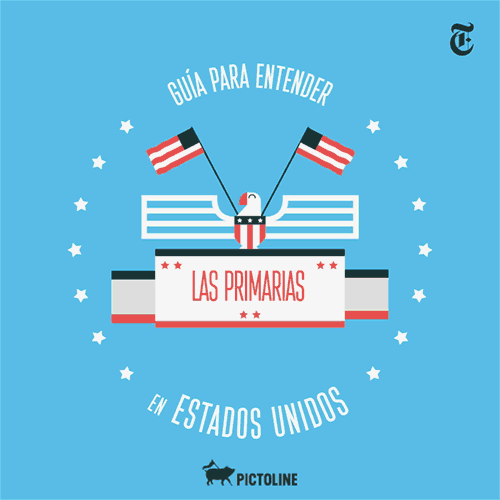If the name Pictoline rings a bell, it’s because you might have seen the outlet’s bright, funny graphics pop up in your Twitter, Facebook and Instagram feeds more and more over the past two years. Identifiable for its short visual explainers — called “bacons” as a nod to the company’s pig mascot — distributed across social media platforms, the Mexico-based company has found a successful business model in sponsored content to undergird its labor-intensive art.
Pictoline was founded in 2015, when it burst into the social media scene with animations and comic-style short explainers like spot news, cartoon posters and data-driven visual stories that quickly gained it a massive audience (their Facebook page, for instance, boasts over 2.5 million followers).
Pictoline has proven not only sustainable but also profitable: In 2016, it earned around US$1 million in revenue, one of its co-founders Gustavo Guzmán told me.
Pictoline’s popularity comes from its focus on cutting through the excess of information available online, according to co-founder and artistic head Eduardo Salles. When it came to competing for people’s time online, images turned out to be the perfect resource.
“Illustration tends to be conceived as a complement of text, as a nice add-on. For us, images are more than that: Our illustrations are the content itself,” he said. “Pictoline has resorted to several formats: posters, political cartoons, animations, cards, comic-style vignettes, infographics, GIFs, platform-enabled content like the carousel on Instagram.”
Salles recalled a conversation with BuzzFeed editor-in-chief Ben Smith that stuck with him, about the favored mediums of outlets in the United States: “Ben told me that they jumped from text to video, and that illustrations were a middle step they just skipped.” In Latin America, with 3G connections and slower internet speeds, images load faster than videos, Salles said; understanding that was a major factor in Pictoline’s success.
Pictoline covers a lot of topics: pop culture, how the brain works, ecology, local and international politics, art and daily trending hashtags. They convey a combination of breaking news and time-sensitive information, together with evergreen posts. Their productions lean progressive and attract a largely millennial audience. Pictoline’s founders don’t expect it to become a media outlet, but a company that designs visual information for different purposes, like brand awareness or education.
Since Pictoline isn’t itself a reporting outfit, it relies on other news media sources for their stories. The material that feeds their posts can come from social media, news outlets from the U.S. and U.K., Spanish-language publications, academic and scientific institutions, Google Trends and also informal channels like WhatsApp groups and regular “people on the street” in Mexico City.
So far, they’re collaborating with two partners for editorial content creation: UNICEF and The New York Times. Working with New York Times en Español, Pictoline was responsible for an early 2016 animation explaining the New Hampshire primaries in the U.S. and an explainer on Super Tuesday. It produced illustrated cards for the “36 Questions That Lead to Love.”

Most recently, Pictoline and the Times collaborated on a graphic story about the crisis in Venezuela and the Times’ correspondent Nick Casey being banned from the country. Salles said that they chose the Times as a partner because they share similar commitment to fact-checking, bolstering the organization’s credibility. Pictoline has helped UNICEF with its “Stickers for Syria” campaign, aimed at raising money and awareness.
It’s business time
Pictoline has tested several revenue sources throughout its existence, but sponsored content has proven to be the most successful. Pictoline is able to operate like a creative agency, according to Guzmán. Pictoline offers the advertisers it works with a branded illustration, distribution of this piece of content across its well-subscribed social networks, and rights to the illustration for the advertiser to post on their own channels.
“The process usually runs really smoothly,” Raúl Pardo, a Pictoline illustrator, said. “We have developed an instinct. We are very reactive to social conversations, and we catch fast where the wind is blowing.”
The entire team is small considering its workload: 16 people total work at Pictoline, including illustrators, editors, writers, social media strategists, developers and salespeople. They produce at least four pieces of content each day, which add up to over 1,500 pieces since Pictoline first launched. (The tally includes editorial posts as well as paid posts.)
Given their accomplishments in Mexico and throughout Spanish-language Latin America, Pictoline’s plans for the future revolve around going international. They remain bullish about the possibility of conquering a U.S. audience, whether that means targeting the entire population more broadly or focusing on the Hispanic audience there. Salles said Pictoline is also interested in expanding into Portuguese-speaking Brazil, and Guzmán also mentioned Mandarin-speaking China and Hindi-speaking India — all big markets with sometimes slower internet connection, where images can be less data-consuming to share than videos.
The company is also launching an “ambassador” program to bring talent from other countries to Mexico. Through this program, they invite guest illustrators from other countries so that they can collaborate with outside talent on new ideas, and these ambassadors can learn from Pictoline’s approach in return.
“We would like to become global by the end of 2017 and the beginning of 2018,” Salles said.
An unabridged version of this post originally appeared on Nieman Lab and is republished with permission.
Image is a screenshot of Pictoline's website.

